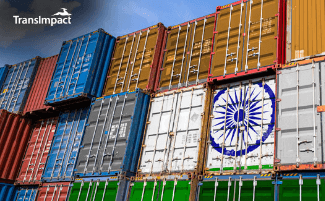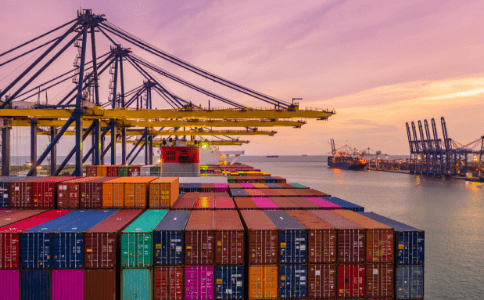The Evolution of Supply Chain Management & Logistics
transimpactin
on
May 11, 2023

The advancement of supply chain management has been a constant process shaped by various factors, including changes in customers buying decisions, technological evolution, and globalization. The supply chain has developed significantly over the years as organizations have realized the use of effective and efficient logistic networks. This evolution paved the way for technology to grow exponentially and enhance customer experience.
The early days of the supply chain were focused fundamentally on logistics and transportation. The main idea behind this was to move products and goods from point A to point B as smoothly as possible, with a crucial emphasis on the management of inventory and the coordination of manufacturers and suppliers.
However, as businesses grew and globalized, the supply chain became more challenging to manage. This led to the innovation of new technologies and software solutions that could help manage the flow of goods and information across multiple business operations. Below are some of the key stages in the development of the supply chain.
An Overview of Supply Chain Management’s Evolution
The supply chain ecosystem has come a long way since its inception, with significant development in transportation and communication technologies.
Pre-Industrial Evolution
During this period, the supply chain was much simpler than it is today. Most products were made by hand, so there were fewer steps involved in the production process. The supply chain was comparatively shorter, with fewer intermediaries between the consumer and the producer.
In the pre-industrial era, people mostly lived in smaller communities. This made it easier for distributors to manage the supply chain, as people could rely on personal relationships and verbal agreements rather than formal contracts.
Industrial Revolution
During the phase of the industrial revolution, supply chain management underwent some critical changes. The development of new technologies, such as steam engines and highly mechanized machines, led to the mass production of goods and services.
This era revolutionized the way products were manufactured and distributed, as it became possible to manufacture goods on a large scale and at a lower cost. The supply chain became complex, with multiple sales channels involved in producing, marketing, and distributing goods.
The industrial revolution was the steppingstone of supply chain optimization, which eventually led to the global trade of goods and the development of the international supply chain.
20th Century
The 20th Century witnessed significant changes and innovation in the supply chain. One of the most important developments was the invention of computers and information technology to manage and coordinate the flow of goods, location, information, and money in the supply chain.
The innovation and introduction of enterprise resource planning (ERP) systems in the 90s was a crucial turning point for the supply chain digitalization process. This led to the rise of just-in-time and lean manufacturing practices. These systems also allowed businesses to integrate their business functions into a singular platform. This made operating inventory, tracking shipments, and coordinating with suppliers and manufacturers easier.
21st Century
The 21st Century has documented the continued evolution of supply chain management, with a keen focus on sustainability, improvements, and the integration of new-generation technologies. The use of advanced technologies such as SaaS, artificial intelligence (AI), blockchain, and SAP improved supply chain visibility and efficiency. These technologies helped companies to enhance their production and distribution processes, reduce excessive waste, and helped improve customer experience.
A significant trend has been increasing focus on sustainability in supply logistic optimization. Businesses are becoming more aware of their supply chains’ environmental and social impacts. They are initiating steps to decrease their carbon footprint and improve working conditions for their employees.
The supply chain has advanced to become a strategic organ within many organizations. Supply chain professionals are responsible for handling supplier relationships, optimizing warehouses with inventory planning software, predicting future demand with demand planning & forecasting software, and ensuring that products are delivered to customers on time and in good condition.
Modern-Day Supply Chain Management Solutions
For the past few years, the supply chain has continued to evolve expeditiously, offering shippers various solutions. Some of the most impacting developments have been:
- Concentration on real-time visibility and risk management, which improves customer satisfaction and reduces customer churn rate.
- Development of end-to-end supply chain, including reverse logistics. This helps businesses to maintain a perfect order rate and observe the entire life cycle of their products.
- Innovation of SaaS-based solutions to avoid supply chain inefficiencies.
- Solutions like inventory planning software enabling businesses to have optimum visibility to maintain leaner supply chains and intelligent transportation strategies.
- Introduction of newer technologies to access greater flexibility and better control for your inventory management to have improved logistic optimization.
Industry Related News
India has climbed up six places on the world banks logistic performance index of India 2023, now ranking 38th in the overall 139 countries index. This is a remarkable boost from their past ranking of 54th in 2014 and 44th in 2018.
What is LPI?
The LPI is an interactive benchmarking entity established by the world bank group. It helps countries identify the opportunities and challenges they face in their performance of logistics and what they can do to enhance their performance to achieve supply chain digitalization.
LPI ranking parameters
- Logistic service quality
- Shipment tracking and tracing
- Ease of arranging shipments
- Timeliness of shipments
- Infrastructure quality
- Custom performance
Transimpact – An Industry Leader in Supply Chain Management Solutions
As a shipper, you have many options for your supply chain needs. But you need a brilliant, custom-made solution to your requirements, and able to work side by side with you. TransImpact offers a leading supply chain optimization system empowering you with data-driven actionable insights and an end-to-end technology solution. For a better understanding of our solution, call our experts or schedule a demo.






